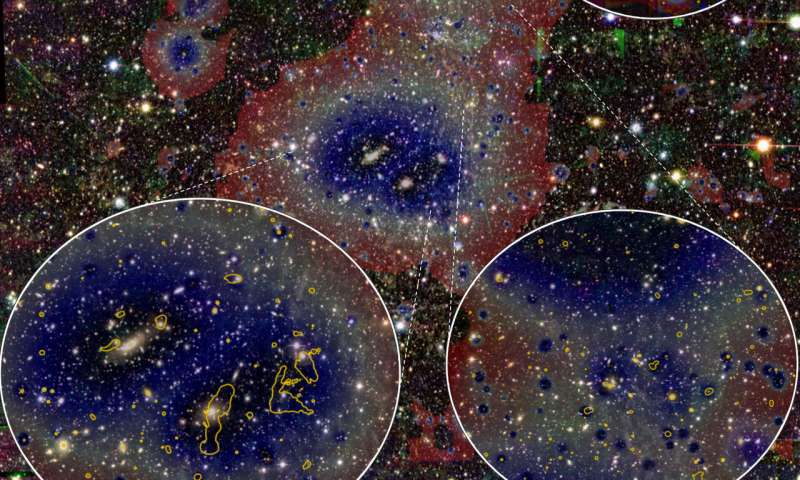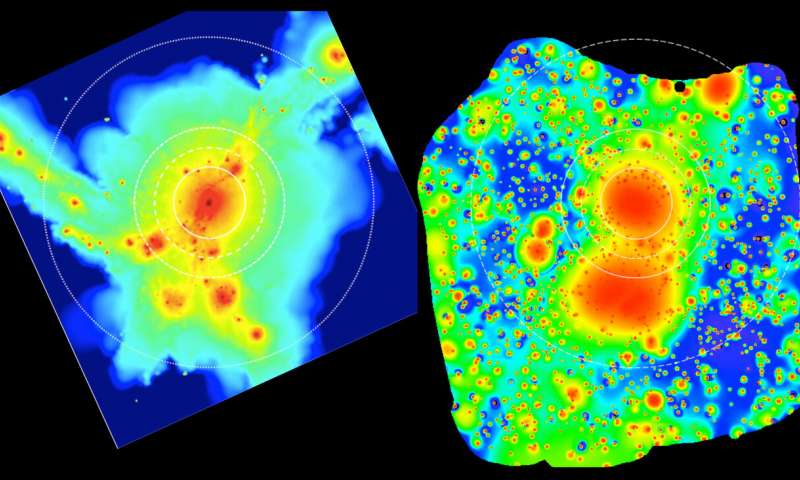This intergalactic filament is 50 million-light-years long, the longest we've ever seen
Extraordinarily long threads of hot gas known as intergalactic filaments connect and surround galaxies and galaxy clusters throughout the cosmos — and scientists just discovered the longest one yet.
intergalactic filaments make up a cosmic web that stretches across the observable universe. Within this structure, galaxies are arranged in a web-like pattern, connected by and surrounded by these filaments.
According to previous research, after the Big Bang jump-started our universe 13.8 billion years ago, a lot of the hydrogen gas that makes up the known matter in the universe collapsed into sheets, which broke apart further into the long, snaking filaments.
Related: The Universe: Big Bang to Now in 10 Easy Steps
Now, scientists led by researchers at the University of Bonn in Germany have observed the longest filament ever found. The gas thread stretches an astounding 50 million light-years, and its structure aligns with predictions made by computer simulations the researchers found, according to a statement released by the University of Bonn.
"According to calculations, more than half of all baryonic matter in our universe is contained in these filaments — this is the form of matter of which stars and planets are composed, as are we ourselves," study lead author Thomas Reiprich, a professor at the Argelander Institute for Astronomy at the University of Bonn, said in the same statement.
Because the filaments stretch so far, the particles that make them up are very spread out, making them extremely difficult to spot. However, Reiprich and his colleagues were able to make the gas completely visible for the first time, by using the eROSITA space telescope, an X-ray telescope built by the Max Planck Institute for Extraterrestrial Physics in Germany, according to the statement.
Breaking space news, the latest updates on rocket launches, skywatching events and more!
"eROSITA has very sensitive detectors for the type of X-ray radiation that emanates from the gas in filaments," Reiprich said about the observations. "It also has a large field of view — like a wide-angle lens, it captures a relatively large part of the sky in a single measurement, and at a very high resolution." These aspects of the space telescope allow researchers to take detailed images of enormous objects like the filaments, and do so relatively quickly.
The team studied Abell 3391/95 — a system of three galaxy clusters 700 million light-years from Earth. The images taken using eROSITA show the clusters and individual galaxies speckling the system, but, perhaps even more amazingly, they show the tendrils that connect the galaxies and clusters, with the entire filament stretching 50 million light-years.
However, while this is the longest filament ever observed, the researchers think that it could be even longer than the section seen in the images, according to the statement.
"We compared our observations with the results of a simulation that reconstructs the evolution of the universe," Reiprich said. "The eROSITA images are strikingly similar to computer-generated graphics. This suggests that the widely accepted standard model for the evolution of the universe is correct."
This work was described in a study accepted for publication in the journal Astronomy & Astrophysics.
Email Chelsea Gohd at cgohd@space.com or follow her on Twitter @chelsea_gohd. Follow us on Twitter @Spacedotcom and on Facebook.

Chelsea “Foxanne” Gohd joined Space.com in 2018 and is now a Senior Writer, writing about everything from climate change to planetary science and human spaceflight in both articles and on-camera in videos. With a degree in Public Health and biological sciences, Chelsea has written and worked for institutions including the American Museum of Natural History, Scientific American, Discover Magazine Blog, Astronomy Magazine and Live Science. When not writing, editing or filming something space-y, Chelsea "Foxanne" Gohd is writing music and performing as Foxanne, even launching a song to space in 2021 with Inspiration4. You can follow her on Twitter @chelsea_gohd and @foxannemusic.


